fuel cap AUDI R8 SPYDER 2015 Owners Manual
[x] Cancel search | Manufacturer: AUDI, Model Year: 2015, Model line: R8 SPYDER, Model: AUDI R8 SPYDER 2015Pages: 232, PDF Size: 58.36 MB
Page 5 of 232
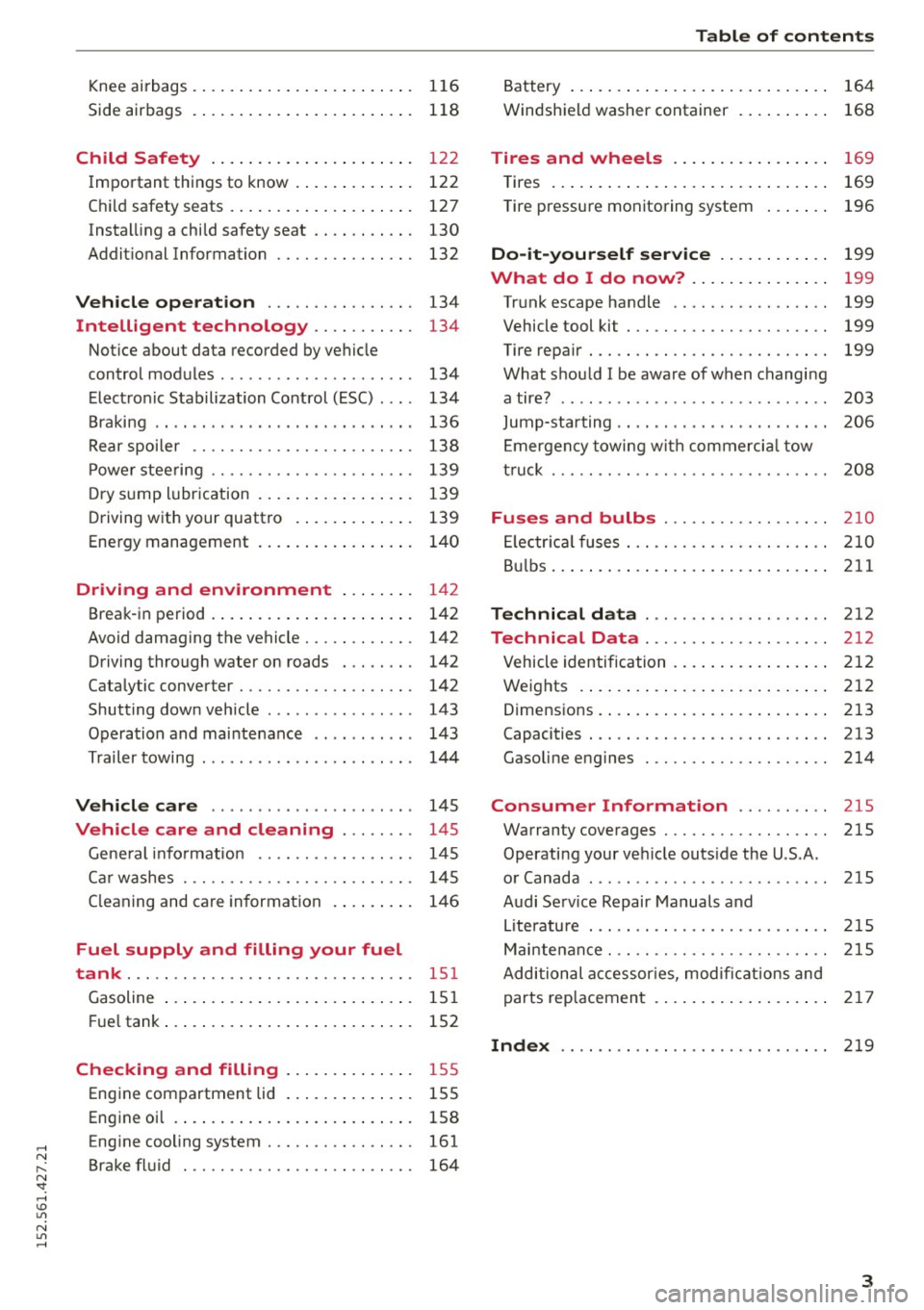
..... N
r-N "': ..... \!) 1.1'1
N 1.1'1 .....
Kneeairbags .. ........... .. .. .. .. ... 116
Side airbags . . . . . . . . . . . . . . . . . . . . . . . . 118
Ch ild Safety . . . . . . . . . . . . . . . . . . . . . . 122
Important things to know . . . . . . . . . . . . . 122
C hild safety seats . . . . . . . . . . . . . . . . . . . . 127
Instal ling a chi ld safety seat . . . . . . . . . . . 130
Additional Information . . . . . . . . . . . . . . . 132
Vehicle operation . . . . . . . . . . . . . . . . 134
Intelligent technology . . . . . . . . . . . 134
Notice about data recorded by vehicle
control modules . . . . . . . . . . . . . . . . . . . . . 134
Electronic Stabilization Control (ESC) . . . . 134
Braking . . . . . . . . . . . . . . . . . . . . . . . . . . . . 136
Rear spoiler . . . . . . . . . . . . . . . . . . . . . . . . 138
Power steering . . . . . . . . . . . . . . . . . . . . . . 139
D ry s ump lubr ication . . . . . . . . . . . . . . . . . 139
Driving with your quattro . . . . . . . . . . . . . 139
Energy management . . . . . . . . . . . . . . . . . 140
Driving and environment . . . . . . . . 142
Break-in period . . . . . . . . . . . . . . . . . . . . . . 142
Avoid damaging the vehicle . . . . . . . . . . . . 142
Driving through water on roads . . . . . . . . 142
Catalytic converter . . . . . . . . . . . . . . . . . . . 142
Shutting down vehicle . . . . . . . . . . . . . . . . 143
Operation and maintenance . . . . . . . . . . . 143
Trailer towing . . . . . . . . . . . . . . . . . . . . . . . 144
Vehicle care . . . . . . . . . . . . . . . . . . . . . . 145
Vehicle c are and cleaning . . . . . . . . 145
General information . . . . . . . . . . . . . . . . . 145
Car washes . . . . . . . . . . . . . . . . . . . . . . . . . 145
Cleaning and care information . . . . . . . . . 146
Fuel supply and filling your fuel
tank ... .. .. .... ............. .. .. .. .
151
Gasoline . . . . . . . . . . . . . . . . . . . . . . . . . . . 151
Fu el tank . . . . . . . . . . . . . . . . . . . . . . . . . . . 152
Checking and filling . . . . . . . . . . . . . . 155
Engine compartment lid . . . . . . . . . . . . . . 155
Engine oil . . . . . . . . . . . . . . . . . . . . . . . . . . 158
Eng ine cooling system . . . . . . . . . . . . . . . . 161
Brake fl uid . . . . . . . . . . . . . . . . . . . . . . . . . 164
Table of contents
Battery . . . . . . . . . . . . . . . . . . . . . . . . . . . . 164
Windshield washer container . . . . . . . . . . 168
Tires and wheel s . . . . . . . . . . . . . . . . . 169
Tires . . . . . . . . . . . . . . . . . . . . . . . . . . . . . . 169
Tire pressure monitoring system . . . . . . . 196
Do-it-yourself service . . . . . . . . . . . . 199
What do I do now? . . . . . . . . . . . . . . . 199
Trunk escape handle . . . . . . . . . . . . . . . . . 199
Vehicle tool kit . . . . . . . . . . . . . . . . . . . . . . 199
Tire repair . . . . . . . . . . . . . . . . . . . . . . . . . . 199
What should I be aware of when changing
a tire? . . . . . . . . . . . . . . . . . . . . . . . . . . . . . 203
Jump-starting . . . . . . . . . . . . . . . . . . . . . . . 206
Emergency towing with commercial tow
truck . . . . . . . . . . . . . . . . . . . . . . . . . . . . . . 208
Fu ses and bulb s . . . . . . . . . . . . . . . . . . 210
El ectr ical fuses . . . . . . . . . . . . . . . . . . . . . . 210
Bulbs......... .. .. ........... .. .. .. 211
Technical data . . . . . . . . . . . . . . . . . . . . 212
Technical Data . . . . . . . . . . . . . . . . . . . . 212
Vehicle identification . . . . . . . . . . . . . . . . . 2 12
Weights . . . . . . . . . . . . . . . . . . . . . . . . . . . 212
Dimensions......................... 213
Capacities . . . . . . . . . . . . . . . . . . . . . . . . . . 213
Gasoline engines . . . . . . . . . . . . . . . . . . . . 214
Consumer Information . . . . . . . . . . 215
Warranty coverages . . . . . . . . . . . . . . . . . . 21S
Operating your vehicle outside the U.S.A .
o r Canada . . . . . . . . . . . . . . . . . . . . . . . . . . 21S
Audi Servi ce Repair Manuals and
Literature . . . . . . . . . . . . . . . . . . . . . . . . . . 215
Maintenance. .. .. ... .......... .. .. .. 215
Additional accessor ies, modifications and
parts replacement 217
Index . . . . . . . . . . . . . . . . . . . . . . . . . . . . . 219
3
Page 12 of 232
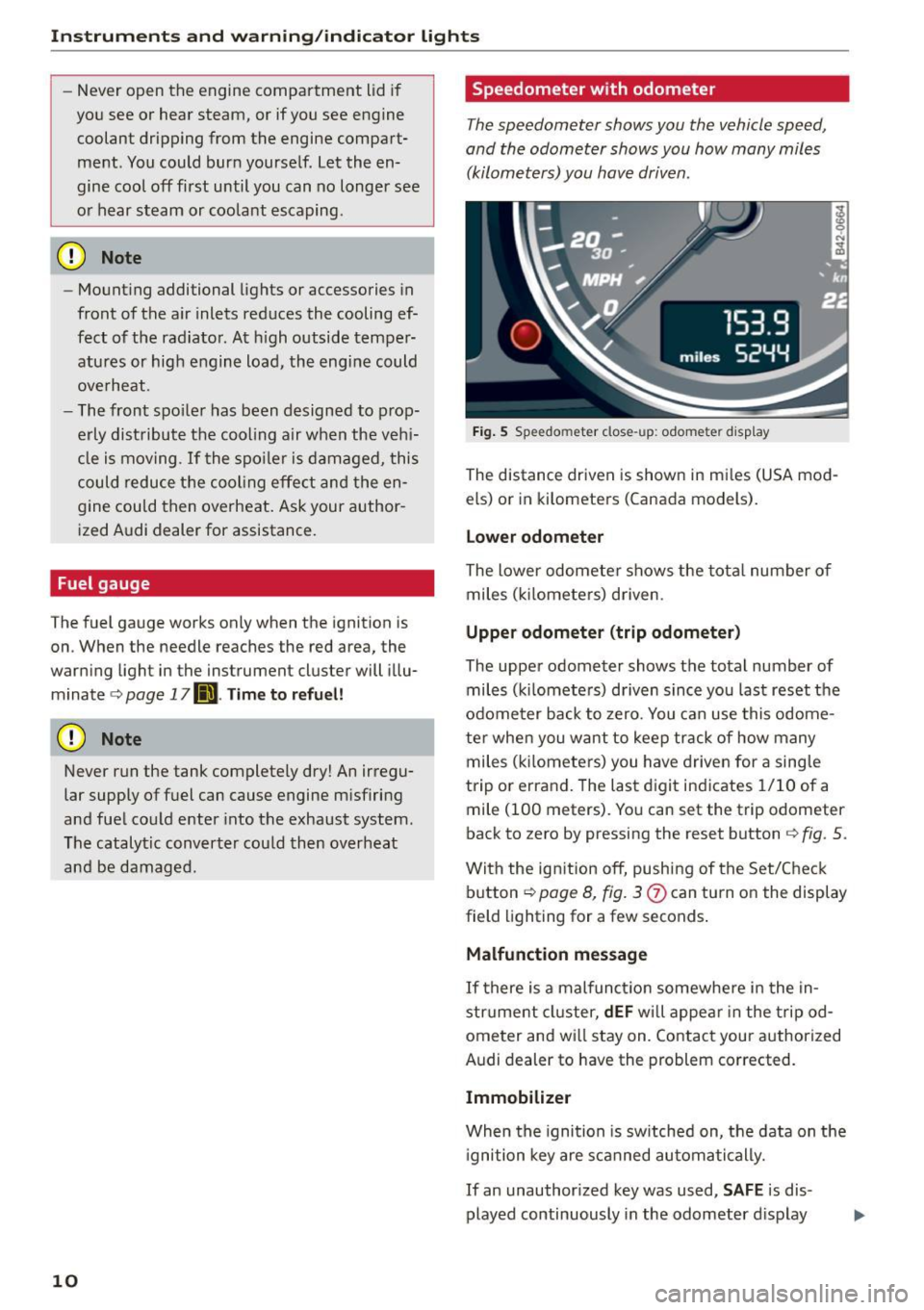
Instrum ent s a nd w arn ing /indi cator lights
-Never open the engine compartment lid if
you see or hear steam, or if you see engine coolant dripping from the engine compart
ment. You could burn yourself. Let the en
gine cool off first until you can no longer see
or hear steam or coo lant escaping .
CD Note
- Mount ing additional lights or accessories in
front of the a ir inlets reduces the cooling ef
fect of the rad iator. At h igh outside temper
atures or high engine load, the engine could
ove rheat.
- The front spo ile r has been designed to prop
erly distribute the cooling air when the veh i
cle is mov ing. If the spo iler is damaged, this
could reduce the cooling effect and the en
gine could then overheat. Ask your author
ized Audi dealer for assistance.
Fuel gauge
The fuel gauge works only when the ignition is
on. When the needle reaches the red area, the
warning light in the instrument cluster will illu
minate
c:> page 17 Ill Time to ref uel!
CD Note
Never run the tank completely dry! An irregu
lar supply of fuel can cause engine m isfiring
and fuel could enter into the exhaust system .
The catalytic converter cou ld then overheat
and be damaged.
10
Speedometer with odometer
The speedometer shows you the vehicle speed,
and the odometer shows you how many miles
(kilometers) you have driven.
Fig. 5 Speedo meter close-up: odometer disp lay
The distance driven is shown in mi les (USA mod
els) or in kilometers (Canada models).
Lower odomet er
The lower odometer shows the tota l number of
miles ( kilometers) driven .
Upper odometer (trip odometer )
The upper odometer shows the total number of miles (k ilometers) driven since you last reset the
odome ter back to zero. You can use this odome
te r when you want to keep track of how many
miles (k ilomete rs) you have driven for a sing le
trip or errand. The last digit ind icates 1/10 of a
mile (100 meters). You can set the trip odometer
back to zero by pressing the reset button
c:> fig . 5 .
With the ig nition off, push ing of the Set/Check
button
c:> page 8, fig. 3
Malfunction messag e
If there is a malfunction somewhere in the in
strument cluster,
dEF wi ll appea r in the tripod
ometer and wi ll stay on. Contact your authorized
Audi dealer to have the problem corrected.
Immobilizer
When the ignition is sw itched on, the data on the
i gnition key are s canned automatically.
If an unauthor ized key was used,
S AF E is dis
played continuously in the odometer d isplay
Page 19 of 232
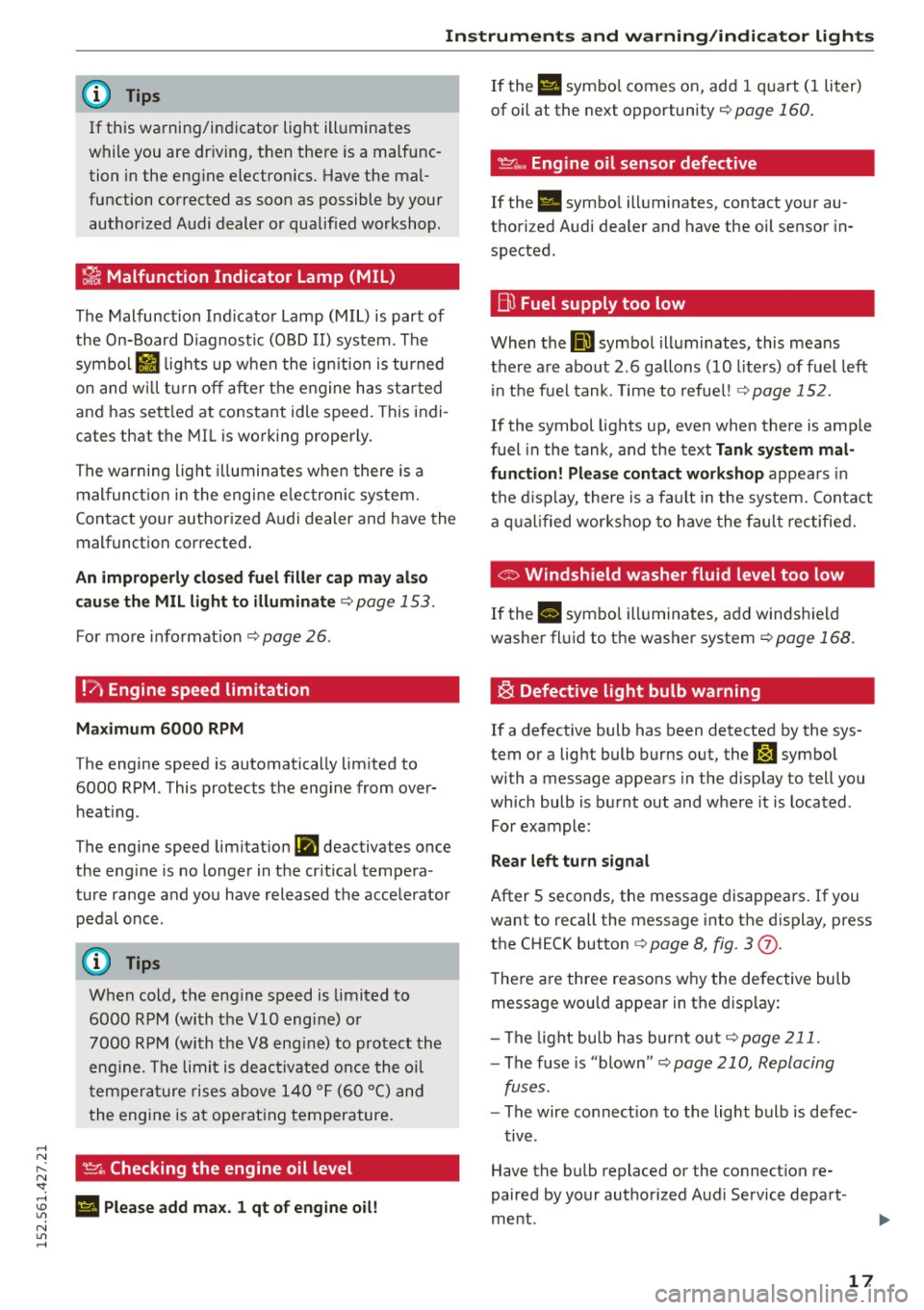
Instrument s and warning /indicator ligh ts
..... N
r-N "':
@ Tips
If this warning/indicator light illuminates
while you are dr iving, then there is a malfunc
tion in the en gine electronics. Have the ma l
function corrected as soon as p ossible by your
author ized Audi dealer or qualified workshop .
~ Malfunction Indicator Lamp (MIL)
The Malfunction Indicator Lamp (MIL) is part of
the On-Board Diagnostic (OBD II) system . The
symbo l
II lights up when the ign ition is turned
on and w ill tur n off after the engine has sta rted
and has sett led at constant idle speed. This indi
cates that the MIL is working properly.
The warning light illuminates when there is a
mal funct ion in the eng ine e lectronic system.
Contact your author ized Audi dealer and have the
malfunct ion corrected .
An improperly clo sed fuel fill er cap m ay al so
cau se th e MIL light to illuminate¢
page 153.
For more info rmat ion ¢ page 26.
!?' Engine speed limitation
Maximum
6000 RPM
T he engine speed is automatically lim ited to
6000 RPM. This protects t he engine from over
heat ing .
The engine speed limit ation
(Pl deac tivates once
the eng ine is no longer in the cr it ica l tempe ra
ture range and you have released the accelerator
pedal once.
When cold, the engine speed is limited to
6000 RPM (with the
VlO engine) o r
7000 RPM (with the V8 eng ine) to protect the
eng ine . T he limit is deac tivated once the o il
t em pera ture rises above 140 ° F (60 °C) and
t he engine is a t ope rat ing temperature .
~. Checking the engine oil level
; El Plea se add max. 1 qt of eng ine oil!
N
"' .....
If the Ell symbo l comes on, add 1 quart (I liter)
of oil at the next opportunity¢
page 160.
~"' Engine oil sensor defective
If the . symbo l ill um inates, contact your au
thori zed Audi dea ler and have the oil sensor in
spected.
B) Fuel supply too low
When the 00] symbol ill uminates, this means
there a re about 2 .6 gallons (10 liters) of fuel left
i n the fue l tank. Time to refue l! ¢
page 152.
If the symbol lights up , even when there is ample
fuel in the tank , and the text
Tank system mal
function! Please contact workshop
appea rs in
t h e d isplay, there is a fa ult in the system. Contact
a q ual ified wor kshop to h ave the faul t rec tified.
© Windshield washer fluid level too low
If the II symbo l ill uminates, add windsh ield
washe r fl uid to t he washer system
¢ page 168.
~ Defective light bulb warning
If a defective bulb has been detected by the sys
tem or a lig ht bulb burns out, the
J:J symbo l
wi th a message appears in the disp lay to tell you
which bulb is burnt out and w here it is located .
For example :
Rear left turn signal
After 5 seconds , the message disappears . If you
want to recall the message i nto the display, press
the CH ECK button ¢
page 8, fig. 3 (j).
The re a re three reasons w hy the defective bulb
message wou ld appear in t he display:
- The light bu lb has bur nt o ut
¢ page 211.
-The f use is "blown" <=-> page 210, Replacing
fuses.
- The wire co nnect ion to the light bulb is defec-
t iv e .
Have the bulb repl aced or the connect ion re
paired by your authorized Aud i Service depart
me nt.
17
Page 28 of 232
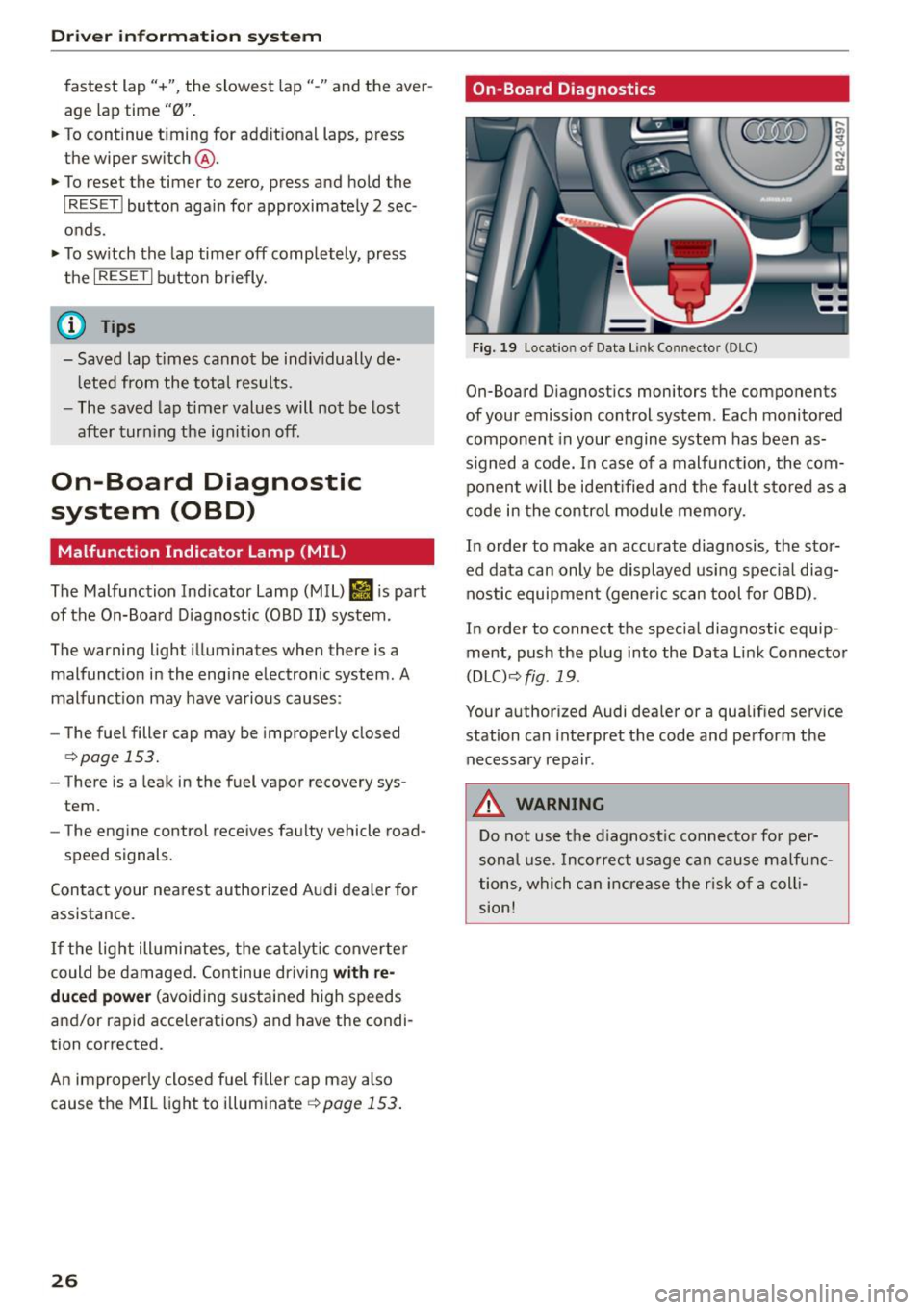
Drive r in formation syste m
fastest lap"+", the slowest lap"-" and the aver
age lap time "0" .
.. To continue t iming for additional laps, press
the wiper switch @ .
.. To reset the timer to zero, press and hold the
I RESET I button again for approximate ly 2 sec
onds .
.,. To sw itch the lap timer off comp letely, press
the
I RES ET I button br iefly.
@ Tips
- Saved lap t imes cannot be ind ividually de
l eted from the total results.
- The saved lap timer values will not be lost
after turn ing the ignit ion off.
On-Board Diagnostic
system (OBD)
Malfunction Indicator Lamp (MIL)
The Malfunction Ind icator Lamp (MIL)
llil is part
of the On-Board Diagnostic (OBD II) system .
The warning light illuminates when there is a malfunct ion in the engine electronic system . A
malfunct ion may have various causes:
- The fuel filler cap may be improperly closed
¢ page 153.
- T here is a leak in the fuel vapor recovery sys
tem .
- The engine control receives faulty vehicle road-
speed signals.
Contact your nearest authorized Audi dealer for
assistance.
I f the light illuminates , the catalyt ic converte r
could be damaged. Continue dr iving
w ith re
du ced pow er
(avoiding sustained high speeds
and/or rapid accelerations) and have the condi
tion corrected.
An improper ly closed fuel filler cap may also
cause the MI L light to illuminate
¢ page 153.
26
On-Board Diagnostics
Fig. 19 Locatio n of Data Li nk Co nnector (DLC)
On-Board D iagnostics monitors the components
of your emission control system. Each monitored component in your engine system has been as
s igned a code. In case of a malfunct ion, the com
ponent will be ident ified and the fault stored as a
code in the control module memo ry.
In order to make an accurate diagnosis, the stor
ed data can only be d isplayed using spec ia l diag
nostic equipmen t (generic scan tool for OBD) .
In order to connect the special diagnostic equip ment, push the plug into the Data Link Connector
(DLC) ¢
fig. 19.
Your authorized Audi dealer or a qualified service
station can interpret the code and perform the
necessary repair .
A WARNING
Do not use the d iagnost ic connector for per
sona l use. Incorrect usage ca n cause ma lfunc
tions, which can increase the r isk of a coll i
sion!
-
Page 154 of 232
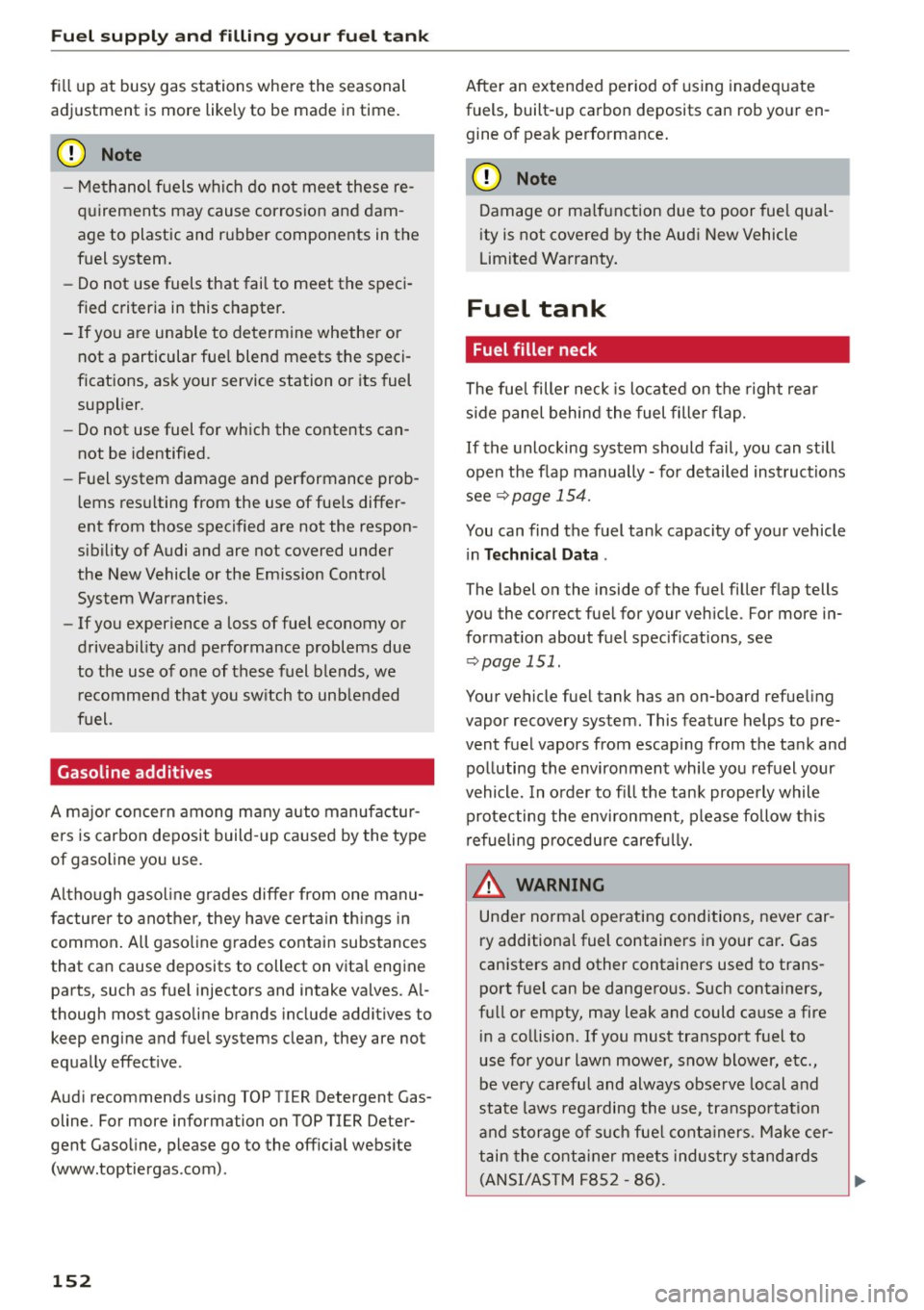
Fuel supply and filling your fuel tank
fill up at busy gas stations where the seasonal
adjustment is more like ly to be made in time.
0 Note
- Methanol fuels which do not meet these re
quirements may cause corrosion and dam
age to plastic and rubber components in the
fuel system.
- Do not use fuels that fail to meet the spec i
fied criteria in this chapter.
- If you are unable to determine whether or
not a particular fuel blend meets the speci
fications, ask your service station or its fuel
supplier.
- Do not use fuel for which the contents can
not be identified.
- Fuel system damage and performance prob
l ems resulting from the use of fuels differ
ent from those specified are not the respon
sibility of Audi and are not covered under
the New Vehicle or the Emission Control
System Warranties.
- If you experience a loss of fuel economy or
driveability and performance problems due
to the use of one of these fuel blends, we
recommend that you switch to unb lended
fuel.
Gasoline additives
A major concern among many auto manufactur
ers is carbon deposit build-up caused by the type
of gasoline you use.
A lthough gasol ine grades differ from one manu
facturer to another, they have certain things in
common. All gaso line grades contain substances
that can cause deposits to collect on vita l engine
parts, such as fuel injectors and intake valves. A l
though most gasoline brands include additives to
keep engine and fuel systems clean, they are not
equally effect ive .
Audi recommends using TOP TIER Detergent Gas
oline. For more information on TOP TIER Deter
gent Gasoline, please go to the official website (www.toptiergas .com).
152
After an extended period of using inadequate
fuels, built-up carbon deposits can rob your en gine of peak performance .
([) Note
Damage or malfunction due to poor fuel qual
ity is not covered by the Audi New Vehicle
Limited Warranty.
Fuel tank
· Fuel filler neck
The fuel filler neck is located on the right rear
s id e panel behind the fuel filler flap.
If the unlocking system should fail, you can still
open the flap manually -for detailed instructions
see
~page 154.
You can find the fuel tank capacity of your vehicle
i n
Technical Data .
The label on the inside of the fuel filler flap tells
you the correct fuel for your vehicle. For more in
formation about fuel specifications, see
~ page 151 .
Your vehicle fue l tank has an on-board refueling
vapor recovery system. This feature helps to pre
vent fuel vapors from escap ing from the tank and
polluting the environment while you refuel your
vehicle. In order to fill the tank properly while
protecting the environment, please follow this
refueling procedure carefully.
& WARNING
-Under normal operating conditions, never car
ry additional fuel containe rs in your car . Gas
canisters and other containers used to trans port f uel can be dangerous. Such containers,
full or empty, may leak and could cause a fire
in a collision. If you must transport fuel to
use for your lawn mower, snow blower, etc., be very careful and always observe local and
state laws regarding the use, transpo rtation
and storage of such fuel containers. Make cer
tain the container meets indus try s tandar ds
(ANSI/ASTM F8S2 -86).
Page 155 of 232
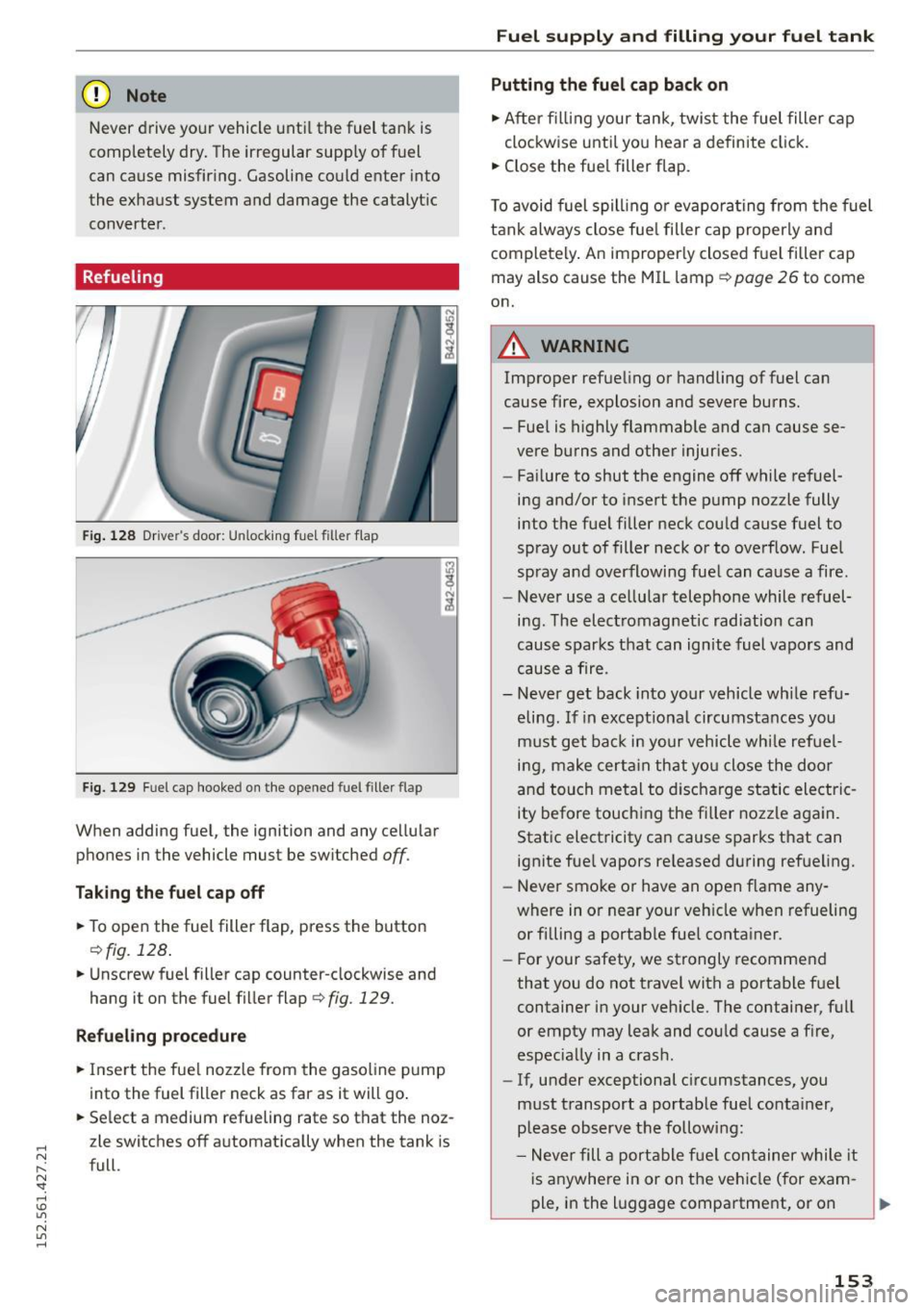
.... N
l'
N "1: .... I.O
"' N
"' ....
(D Note
Never drive yo ur vehicle unti l the fuel tank is
completely dry . The irregular supp ly of fuel
can cause misfir ing. Gasoline co uld enter into
the exhaust system and damage the catalyt ic
converter .
Refueling
F ig. 12 8 Drive r's door: Unlocking f uel filler f lap
F ig . 129 Fu el cap hooke d on th e opene d fu el fil ler fla p
When adding fuel, the ignition and any cellular
phones in the vehicle must be sw itched
off .
Taking the fuel cap off
.. To open the fuel filler flap, press the button
¢ fig. 128 .
.. Unscrew fuel filler cap counte r-clockwise and
hang it on the fuel filler flap
¢ fig. 129.
Refueling procedure
.. Inse rt the fue l nozz le from the gasoline pump
into the fuel filler neck as far as it will go .
.. Se lect a medium refueling rate so that the noz
z le switches off automat ica lly when the tank is
full.
Fuel supply and filling your fuel tank
Putting the fuel cap back on
.,. After f illing your tank, twis t the fuel filler cap
clockw ise unti l yo u hear a definite cl ick .
.. Close the fue l filler flap.
T o avoid fuel spill ing o r evapora ting from the fuel
tank always close fue l filler cap properly and
complete ly . An improper ly closed f uel filler cap
may also cause the MIL lamp ¢
page 26 to come
on.
A WARNING
--Improper refue ling or handling of fuel can
cause fire, explosion and severe burns.
- Fue l is highly flammable and can cause se
vere burns and other injur ies.
- Fa ilure to shut the engine off while re fuel
ing and/or to insert the pump nozzle fully
into the fue l filler neck cou ld cause fuel to
spray out of filler neck or to overflow. Fue l
sp ray an d overflowing fue l can ca use a fire.
- Never use a ce llular telepho ne while refuel
ing . T he elec tromagnetic radiation can
cause sparks that can ignite fuel vapo rs and
cau se a fire .
- Never get back into yo ur vehicle wh ile refu
e ling . If in except iona l circumst ances you
m ust get ba ck in yo ur vehicle whi le refuel
i n g, make cert ain that yo u close the doo r
a nd tou ch me tal to disch arge st atic electric
ity before touch ing the filler nozzle aga in.
Static elect ricity ca n cause s parks that can
ignite fue l vapors re leased d uring refueling.
- Never smoke o r have an open f lame any
where in or near your veh icle w hen refueling
or fi lling a portab le fue l conta iner.
- For your safety, we strongly recomme nd
that you do not travel with a portable f uel
container in your veh icle. The container, f ull
or empty may leak and cou ld cause a f ire,
especia lly in a cras h .
- If, under exceptional c ircumstances, you
must t ransport a po rtab le fuel conta iner,
p lease observe t he follow ing :
- Never fill a por table fuel co ntainer while it
is anywhere in or on the veh icle (for exam -
p le, in the l uggage compa rtme nt, or on ..,.
153
Page 156 of 232
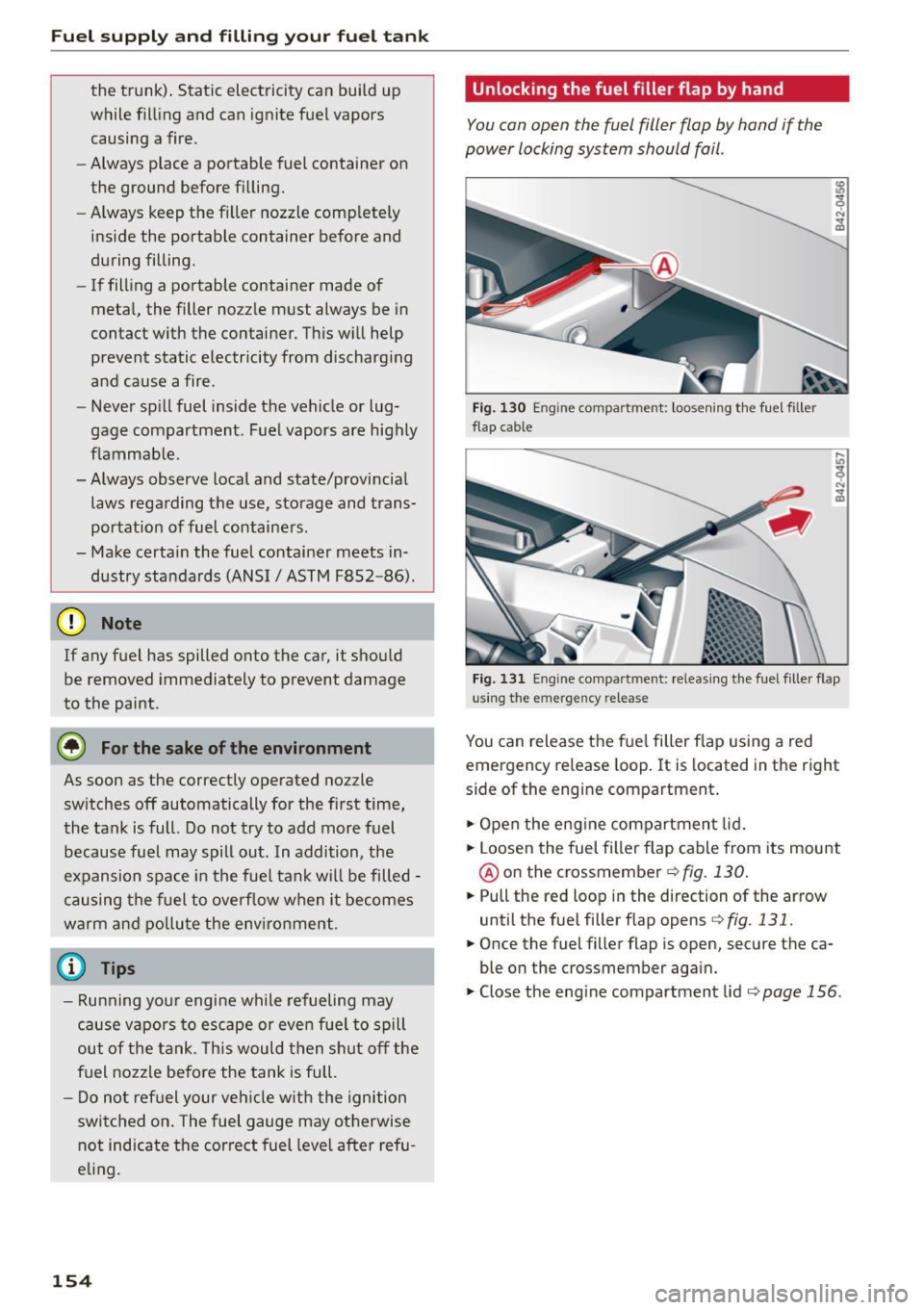
Fuel supply and filling your fuel tank
the trunk). Static electricity can build up
while filling and can ignite fuel vapors
causing a fire.
- Always place a portable fuel container on
the ground before f illing.
- Always keep the fi ller nozzle comp letely
inside the portable container before and
during filling.
- If filling a portable container made of
metal, the filler nozzle must always be in
contact with the container. This will help prevent static electricity from discharging
and cause a fire .
- Never sp ill fuel inside the vehicle or lug
gage compartment. Fuel vapors are highly
f la mmab le.
- Always observe local and state/provincial
laws regarding the use, storage and trans
portat ion of fuel containers.
- Make certain the fuel container meets in
dustry standards (ANSI/ ASTM F8S2 -86) .
(D Note
If any fuel has spilled onto the car, it should
be removed immediately to prevent damage
to the paint .
@ For the sake of the environment
As soon as the correctly operated nozzle
switches off automatically for the first time,
the tank is full. Do not try to add more fuel
because fuel may spill out. In addition, the
expansion space in the fuel tank will be filled -
causing the fuel to overflow when it becomes
warm and pollute the enviro nment.
@ Tips
- Running your engine while refueling may
cause vapors to escape or even fue l to spill
out of the tank. This would then shut off the
fuel nozzle before the tank is full.
- Do not refuel your vehicle w ith the ignition
switched on . The fuel gauge may otherwise
not indicate the correct fuel level after refu
e ling.
154
Unlocking the fuel filler flap by hand
You can open the fuel filler flap by hand if the
power locking system should fail .
Fig. 130 Engine compartme nt: loosening the fuel filler
flap cable
Fig. 131 Eng ine compa rtment: releasing the fuel filler flap
using the emergency re lease
You can release the fue l filler f lap using a red
emergency release loop . It is located in the right
side of the engine compartment .
.,. Open the engine compartment lid.
.,. Loosen the fuel filler flap cable from its mount
@ on the crossmember
r::;, fig. 130 .
.,. Pull the red loop in the direction of the arrow
until the fue l filler flap opens
r::;, fig. 131.
.,. Once the fuel filler flap is open, secure the ca
ble on the crossmember again .
.,. Close the eng ine compartment lid
r::;, page 156.
Page 158 of 232
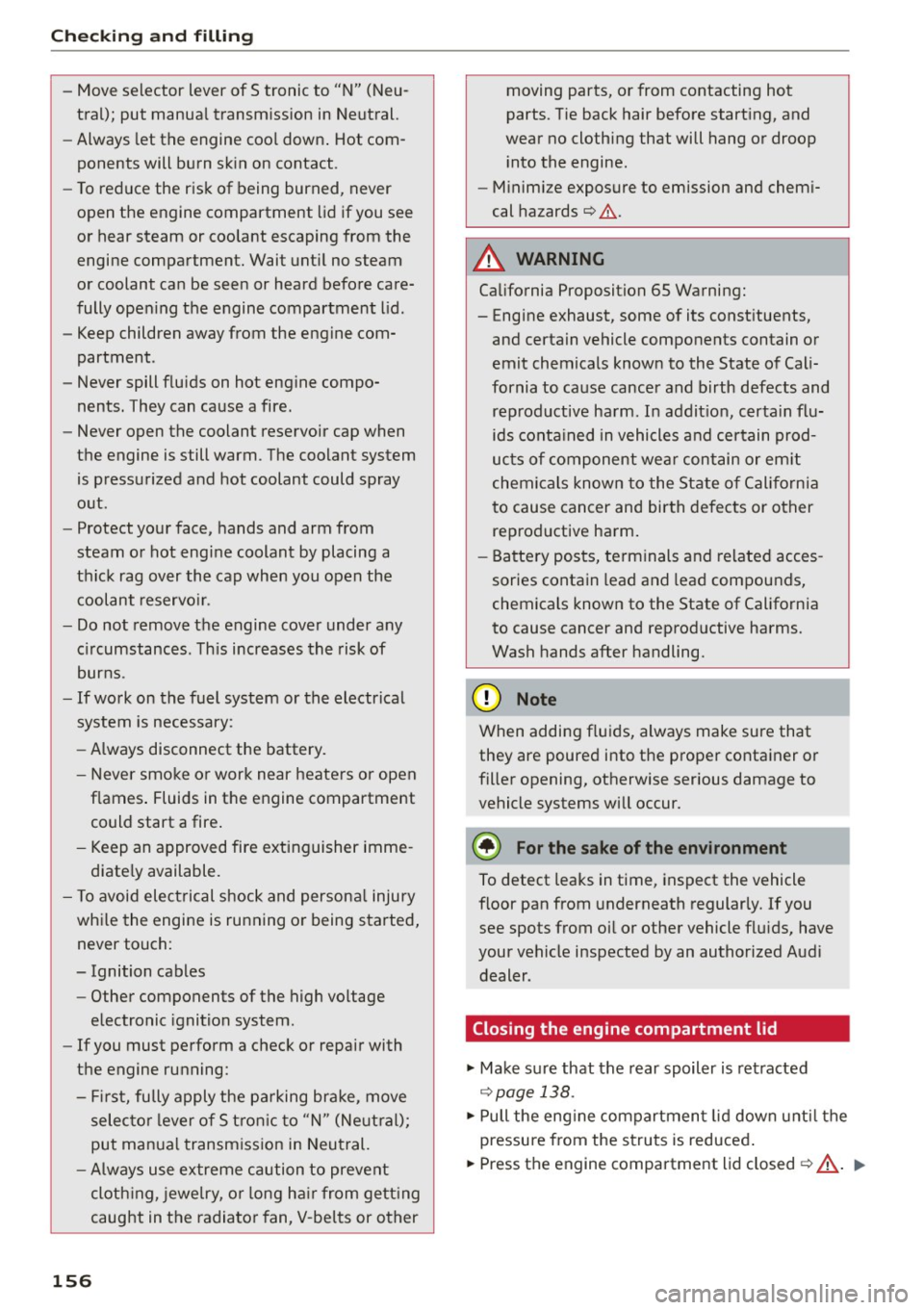
Checking and filling
-Move selector lever of S tronic to "N" (Neu
tral); put manual transmission in Neutral.
- Always let the engine cool down. Hot com
ponents will burn skin on contact .
- To reduce the risk of being burned, never
open the engine compartment lid if you see
or hear steam or coolant escaping from the
engine compartment. Wait until no steam
or coolant can be seen or heard before care
fully opening the engine compartment lid.
- Keep children away from the engine com
partment .
- Never spill fluids on hot engine compo
nents. They can cause a fire.
- Never open the coolant reservoir cap when
the engine is still warm . The coolant system
is pressurized and hot coolant could spray
out .
- Protect your face, hands and arm from
steam or hot engine coolant by placing a
thick rag over the cap when you open the coolant reservoir .
- Do not remove the engine cover under any
circumstances . This increases the risk of
burns.
- If work on the fuel system or the electrical
system is necessary :
- Always disconnect the battery.
- Never smoke or work near heaters or open
flames. Fluids in the engine compartment
could start a fire.
- Keep an approved fire extinguisher imme
diately available .
- To avoid electrical shock and personal injury
while the engine is running or being started,
never touch:
- Ignition cables
- Other components of the high voltage
electronic ignition system.
- If you must perform a check or repair with
the engine running:
- First, fully apply the parking brake, move
selector lever of S tronic to
"N" (Neutral);
put manual transmission in Neutral.
- Always use extreme caution to prevent
clothing, jewelry, or long hair from getting
caught in the radiator fan, V-belts or other
156
moving parts, or from contacting hot
parts. Tie back hair before starting, and
wear no clothing that will hang or droop into the engine.
- Minimize exposure to emission and chemi
cal hazards
¢ .&..
A WARNING
California Proposition 65 Warning:
- Engine exhaust, some of its constituents,
and certain vehicle components contain or
emit chemicals known to the State of Cali
fornia to cause cancer and birth defects and reproductive harm. In addition, certain flu
ids contained in vehicles and certain prod
ucts of component wear contain or emit
chemicals known to the State of California
to cause cancer and birth defects or other
reproductive harm.
- Battery posts, terminals and related acces
sories contain lead and lead compounds,
chemicals known to the State of California
to cause cancer and reproductive harms.
Wash hands after handling.
@ Note
When adding fluids, always make sure that
they are poured into the proper container or
filler opening, otherwise serious damage to
vehicle systems will occur.
@ For the sake of the environment
To detect leaks in time , inspect the vehicle
floor pan from underneath regularly. If you
see spots from oil or other vehicle fluids, have
your vehicle inspected by an authorized Audi
dealer .
· Closing the engine compartment lid
.. Make sure that the rear spoiler is retracted
¢page 138 .
.. Pull the engine compartment lid down until the
pressure from the struts is reduced.
.. Press the engine compartment lid closed
¢ _A . ..,
Page 174 of 232
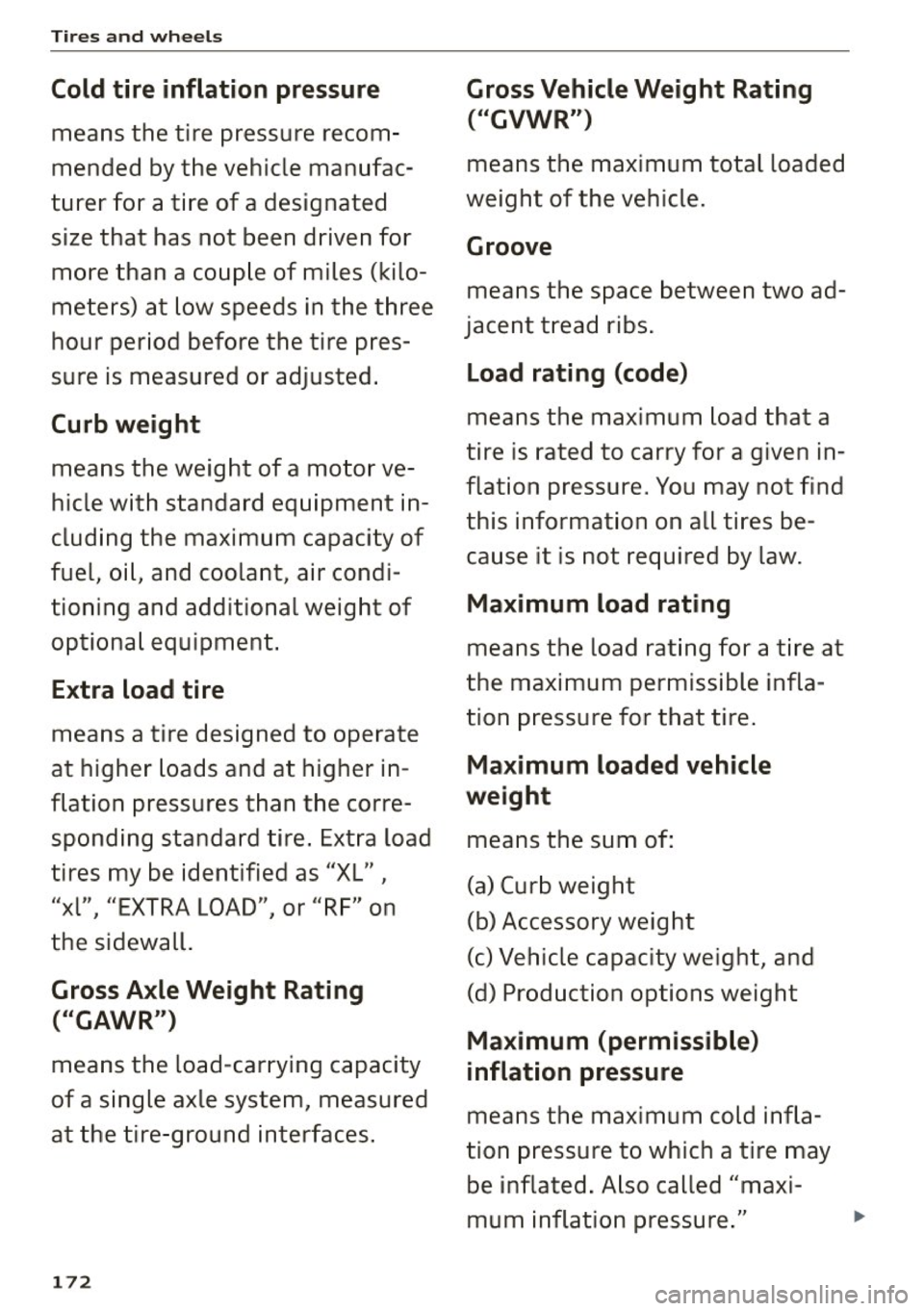
Tires and wheels
Cold tire infl ation pre ssure
means the tire pressure recom
mended by the vehicle man ufac
turer for a tire of a designated
size that has not been driven fo r
more than a couple of miles (kilo
meters) at low speeds in the three
hour period before the tire pres
sure is measured or adjusted .
Curb weight
means the weight of a motor ve
hicle with standard equipment in
cluding the maximum capacity of
fuel, oil, and coolant, air condi
tioning and additiona l weight of
optional equipment.
E x tra load tire
means a tire designed to operate
at higher loads and at higher in
flation pressures than the corre sponding standard tire. Extra load
tires my be identified as "XL",
"xl ", "EXTRA LOAD", or "RF" on
the sidewall.
Gross Axle Weight Rating ("GAWR" )
means the load-carrying capacity
of a single axle system, measured
at the tire -ground interfaces.
1 72
Gross Vehicle Weight Rating
("GVWR")
means the maximum total loaded
weight of the vehicle.
Groove
means the space between two ad
jacent tread ribs.
Load rating (code )
means the maximum load that a
tire is rated to carry for a given in
flation pressure . You may not find
this information on all tires be
cause it is not required by law .
Maximum load rating
means the load rating for a tire at
the maximum permissible infla
tion pressure for that tire .
Maximum loaded vehicle
weight
means the sum of :
(a) Curb weight
(b) Accessory weight
(c) Vehicle capacity weight, and
(d) Production options weight
Ma ximum (permissible )
inflation pressure
means the maximum cold infla
tion pressure to which a tire may be inflated. A lso called "maxi-
mum inflation pressure ." .,.
Page 184 of 232
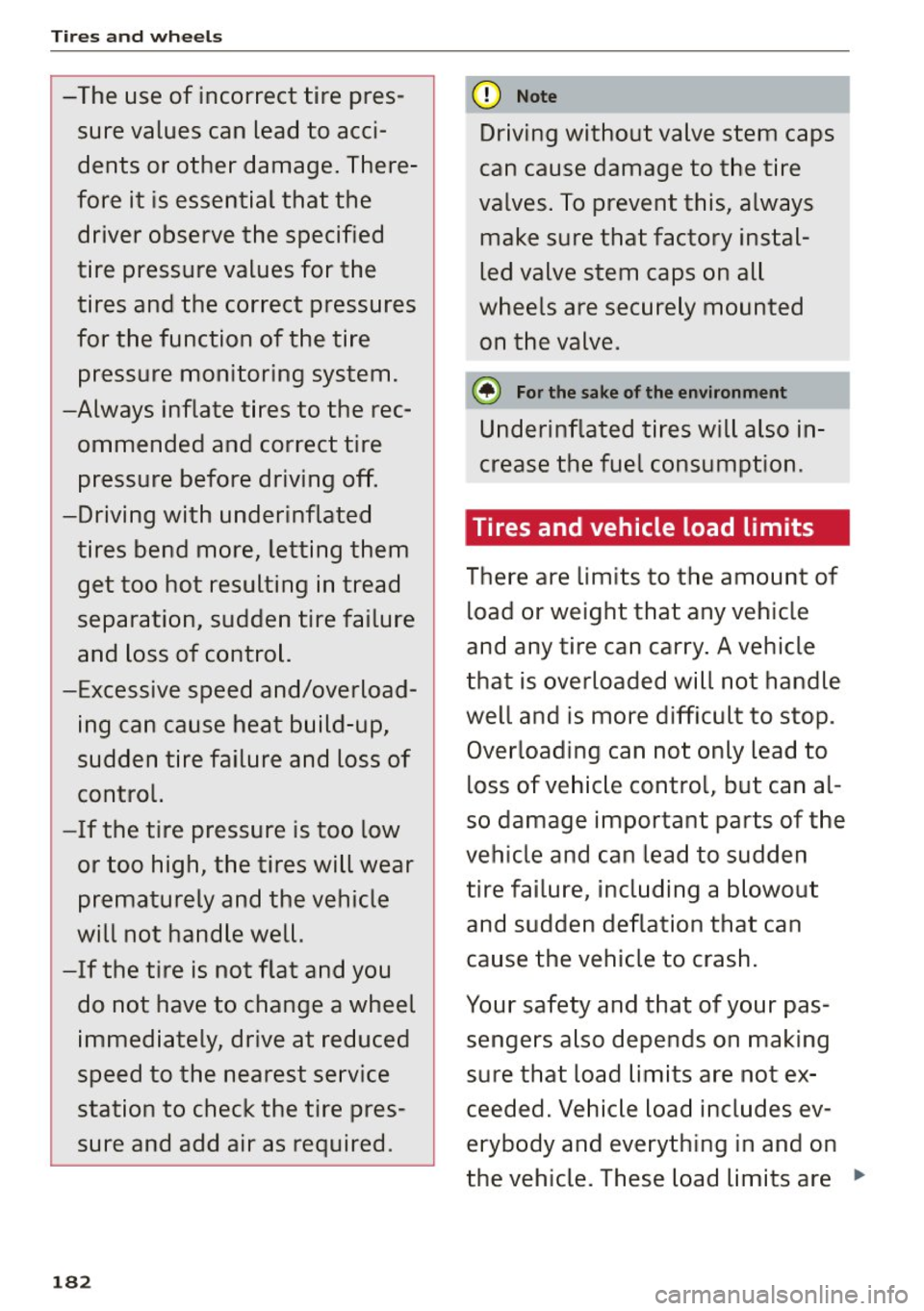
Tires and wheels
-The use of incorrect tire pressure values can lead to acci
dents or other damage. There
fore it is essential that the driver observe the specified
tire pressure values for the
tires and the correct pressures
for the function of the tire pressure monitoring system.
-Always inflate tires to the rec ommended and correct tire
pressure before driving off.
-Driving with underinflated tires bend more, letting them get too hot resulting in tread
separation, sudden tire failure
and loss of control.
-Excessive speed and/overload
ing can cause heat build-up,
sudden tire failure and loss of
control.
-If the tire pressure is too low
or too high, the tires will wear
prematurely and the vehicle
will not handle well.
-If the tire is not flat and you do not have to change a wheel
immediately, drive at reduced
speed to the nearest service
station to check the tire pres
sure and add air as required .
182
d) Note
Driving without valve stem caps
can cause damage to the tire
valves. To prevent this, always
make sure that factory instal
led valve stem caps on all
wheels are securely mounted on the valve.
@ For the sake of the environment
Underinflated tires will also in
crease the fuel consumption.
Tires and vehicle load limits
There are limits to the amount of
load or weight that any vehicle
and any tire can carry. A vehicle
that is overloaded will not handle
well and is more difficult to stop. Overloading can not only lead to
loss of vehicle control, but can al
so damage important parts of the
vehicle and can lead to sudden
tire failure, including a blowout and sudden deflation that can
cause the vehicle to crash.
Your safety and that of your pas
sengers also depends on making
sure that load limits are not ex
ceeded. Vehicle load includes ev
erybody and everything in and on
the vehicle. These load limits are ...